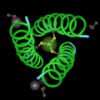Sometimes words fail me. Luckily, we have videos.
Many of you have probably read about Roger Tsien receiving the Nobel Prize this work for his work with the green fluorescent protein (GFP), but I bet some of you are wondering, why a jellyfish protein is worth a Noble Prize.
 I think one of the best places to see why GFP is important, and also to see what some scientists do during the day, is JOVE, the Journal of Visualized Experiments.
I think one of the best places to see why GFP is important, and also to see what some scientists do during the day, is JOVE, the Journal of Visualized Experiments.
The wonderful video, that's shown in this image, describes a new method for investigating Parkinson's disease. This is the kind of biological work that we need in order to understand the results of genome wide association studies.
Simply identifying a gene that's associated with Parkinson's disease doesn't give us enough information to do something about it. We want to be able to understand what the gene does and why mutations in that gene might cause problems. Looking at protein structures is helpful, as I showed earlier, but if we're really going to understand what the protein does, we need to see what's going on inside of an animal.
Worms, like C. elegans, are nice because we can grow them in a dish and see through them with a microscope. In this video, we get to see how GFP is used to evaluate the health of dopamine-producing neurons, in presence of different mutations.
